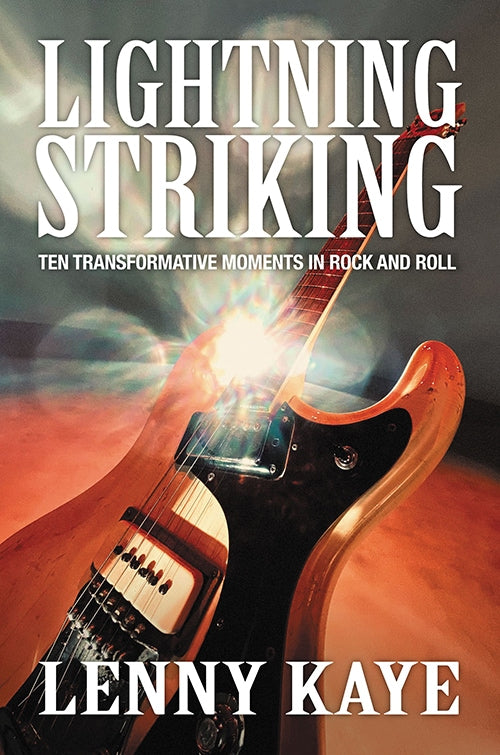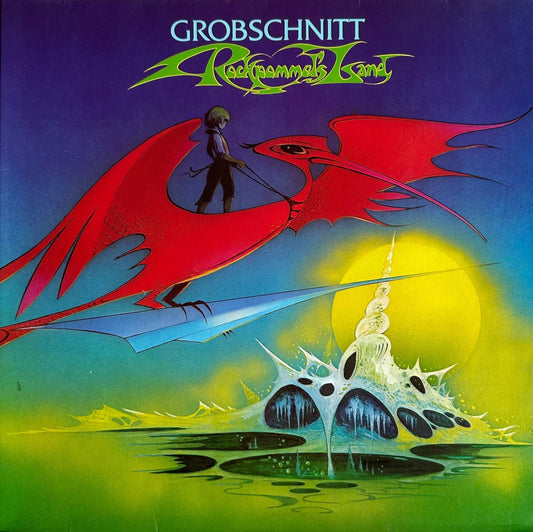If you can measure a book by its playlist, Lenny Kaye’s Lightning Striking surfs peak rock’n’roll moments, a music history that leaks pleasure. Its songs trace hidden galaxies in an exploding universe of ideas and feelings, and maps new orbits through a music that never stops revealing itself. Kaye grew up in southern New Jersey, fled to the West Coast as a teenager and then lower Manhattan in the early 1970s, a road tripper in search of scenes. He resembles that subspecies of scenester who plugs away furiously as an awestruck participant, following the music religiously as both an acolyte and then sideman. The right-place right-time karma has him backing up an early Patti Smith poetry reading in St. Mark’s Church, Greenwich Village, in 1971. “It was only supposed to happen once.” He has been leading her band ever since. You might know Kaye as an avid librarian of garage-rock lore, compiling the first Elektra LP edition of Nuggets: Original Artyfacts from the First Psychedelic Era 1965 – 1968 in 1972, and then many of its spinoffs. Little Steven’s Underground Garage project works, in a way, as an homage to the cathedral that Kaye first built. This affection for history reveals itself through the Patti Smith Group’s ardent covers. The Who’s ”My Generation” once had a sacred position as that band’s closer, but she often opened with the Velvet Underground’s “We’re Gonna Have a Good Time Together,” or folded in the Leaves’s “Hey Joe,” and, of course, the Byrds’s “So You Want to Be a Rock’n’Roll Star,” channeling far more legacy than many other punk acts.

The book highlights ten different locales and turns geography into metaphor for states of mind, world-views, and cackling tirades for where meanings go fizzy; bullet points to destiny. (The list: Memphis, 1954. New Orleans, 1957. Philadelphia, 1959. Liverpool, 1962. San Francisco, 1967. Detroit, 1969. New York, 1975. London, 1977. Seattle, 1991. Los Angeles, 1984 / Norway, 1993. Skipping Boston looks like the most glaring oversight.) Each locale gets such detailed treatment you sense a heightened awareness of how many disparate characters and their kismet collisions create a larger story about pickled fate, an unstoppable style, and new worlds of sound that quickly overtook any single figure or band. His history starts with his sponge-like ears as a teen, a doo-wop aficionado and New Orleans obsessive who adores all the inside jokes, open secrets, and sainted clown of the young style as only feisty kids can. He conveys the giant disruption of the Beatles in 1964 without diving much into their material, and sidesteps most of the other pitfalls of this well-plowed turf with sizzling details and cryptic maxims, his paragraph-thumping Zen koans turn as tempting as his dangling questions (”Who knows where a hit begins?”). Kaye’s voice, while sometimes cryptic, distills style into tart locutions: “How to sing to a girl. In the voice of a girl. That is Philadelphia’s tradition.” Or, “Records are all about need. That you’re not yet aware of. Heartbreak, heart back together, some dance floor somewhere, A favorite song for you to play along...” or this, his immaculate summary of Beatlemania: “Yeah times three. The mathematics of dream.” Kaye finds his subject’s rhythm and mood, unveils a new score for its soundtrack, all the while convincing you your own playlist matters most: so many portals into this story, his own just one of lifetimes worth pursuing. He dashes about, compresses exhilarating records into frenetic prose, and outlines a new rendition of this familiar story that sends you back to your stash, hunting down new obscurities, and grooving to new pleasures. It’s the perfect book for the streaming era: YouTube tosses up many of these quickly, thrills chasing thrills. The travelogue grid means he returns over and over again to the Sixties, which provides multiple angles on music that seemed to explode all at once in various places and yet always held sway against itself; many voices speaking as one.
You may have known about Richie Adams, who sang lead for the Archies (”Sugar Sugar”), but not that he first appeared as the lead on the Fireflies’s “You Were Mine” back in 1959, and Bobby Lewis’s “Tossin’ and Turnin’” in 1961, or went on to write Englebert Humperdinck’s “After the Lovin.’” How many such vicarious Bert Berns figures hide in pop’s shadows? Here’s how Kaye describes Memphis producer Sam Phillips, of Sun Records:
His apocryphal wish fulfillment — “If I could find a white man with the Negro sound, and the Negro feel”— is too reductive, too easy. For Sam, the music’s sui generis starts with what is called rhythm and blues. And what is called country and western. Big-band orchestras and Appalachian balladry and show tune standards and gospel of all persuasions.
The persistent curiosity of Kaye’s ear cranks out new frames like a movie projector inventing its own film. A typical sentence the crams in the pressures of capitalism alongside the heated momentum of creativity: “Cosimo starts a record company, Nola, and has a hit out of the box with Robert Parker’s 1966 ‘Barefootin’,’ but can’t turn up the cash flow like he could boost the bottom end at his studio, unable to press enough records to meet demand...” From inside the Summer of Love, he writes, “Sometimes it seems as if the Western world is in kaleidoscopic spin...” Every page yields zircons like these palmed descriptions: of Duane Eddy (”Whoops and a low-stringed sound hollowed out by the reverb of a grain tank in Arizona”), Stooges guitarist James Williamson (”He has a determined alpha dog sense of riffage that bends the substructure of the Stooges his way”), the Talking Heads (”art-savvy and paranormal), or Janis Joplin (”Alkedelic...”).
When he gets to the Beatles, he lets a few choice paragraphs do all the work, then fleshes out the surrounding context: What is it about the Fabulist Four, the perfect quartet, that sets them apart, beyond their peers, their generation, even the idea of pop music itself? They sound more randomly weird as we get equidistant from their time frame, untethered from the progression of genres that mark their contemporaries. They lead by example, and yet the results hew to no predictable landscape, blending instruments and style and overreach. That still, after these many years and maddening familiarity with each of their songs, they are capable of surprise; the revealing scope and sophistication of their musical imagination; the way each personality jigsaws together for an all-too-brief decade, and then the inevitable solo albums, individual brilliance showing how much they relied on each other to make a four-ever magic. Then this:
Their creation encapsulates the cultural transformations of the 1960s. The voyage between “She Loves You” to the endgame of “I Am the Walrus,” with all the magnificent shards of creativity in between, spreads across the take-anything spectrum of popular music, the heart on the sleeve and the bite in the tongue, sound collage and lyrics a-twist with layers of meaning and mnemonic, instruments chosen without regard to what has come before, each phrase and hook and texture of arrangement existing as if it always meant to be there. Decades later we arrive at bio-discography through outtake, remix, remaster. Every anniversary commemorated; the emphasis on process rather than the songs themselves. Snippets of studio conversation, live performances, works in progress, false starts, all show our desire to know how it was done, how four musicians could make such incessantly interesting music, and have it change the course of popular music.
Connecting unlikely dots like a good historian, Kaye makes you hear each end of things differently. John Simon, the producer who made the first two Band albums sound so rustic, had already produced the first Big Brother and the Holding Company record, Cheap Thrills, the one with the cover by cartoonist Robert Crumb. Kaye’s deep dive into Detroit garage band history follows the threads leading to the MC5 and the Stooges, who each tower in new and fascinating ways here. But Kaye also off-ramps into a quick description of the regional energies unfurling throughout the lo-fi DIY epoch of 1966: nationally — Minneapolis, and the Castaways (“Liar Liar”), Chicago, and the Shadows of Knight (“Gloria”), Cleveland, and the Outsiders (“Time Won’t Let Me”). Michigan seemed especially fertile territory when Tommy James and the Shondells’ “Hanky Panky” (from Niles), and ? and the Mysterians’ “96 Tears” (from Bay City and Saginaw) both topped the charts in 1966. Sonic Youth “picks up where
While in the Record Plant we’re visited by Bruce Springsteen, working on what will be Darkness at the Edge of Town down the hall. Jimmy



